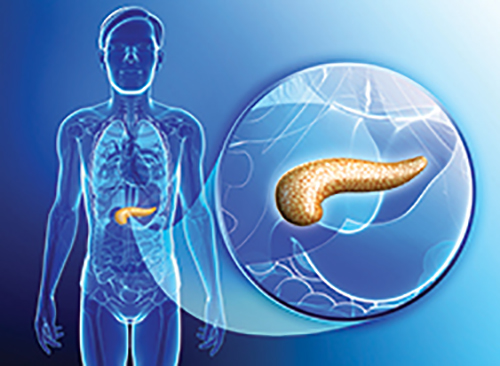Salk researchers have identified a new set of molecules that fuel the growth of tumors in pancreatic ductal adenocarcinoma (PDAC), the most common type of pancreatic cancer.
The new research findings indicate how certain gene mutations trigger out-of-control growth in pancreatic cancer by activating a “super-enhancer” that turns on other genes. The studies, including experiments in live mice, also showed the effectiveness of a new drug that put the brakes on pancreatic cancer growth by blocking the effects of the super-enhancer.
“This is the first time anyone has looked in such detail at the role of super-enhancers in pancreatic cancer,” said Salk Professor Ronald Evans, PhD, director of Salk’s Gene Expression Laboratory. “The discovery of this super-enhancer gives us both basic insight into PDAC and a new way to think of therapies.” Evans is senior author of the team’s published paper in Nature Communications, titled “A super-enhancer-regulated RNA-binding protein cascade drives pancreatic cancer,” in which they say the study identifies “unexpected therapeutic targets for PDAC.”
Pancreatic cancers are among the most aggressive, deadly tumor types, with pancreatic ductal adenocarcinoma accounting for more than 90% of all pancreatic cancer cases. With a five-year survival rate 11%, pancreatic cancer is also predicted to become the second leading cause of cancer-related death in the U.S. this decade, the authors reported. “Pancreatic ductal adenocarcinoma (PDAC) is a lethal malignancy in need of new therapeutic options,” they stated. “Directly targeting known oncogenic drivers of PDAC, such as MYC and KRAS, has been historically challenging.”
Enhancers are regions of DNA that, when bound by proteins, boost the expression of genes. This results in higher levels of those genes’ protein products. Super-enhancers are the most active type of enhancer, and they can be identified by their unique molecular tags. Because super-enhancers can simultaneously and powerfully activate many genes, they can rapidly change the state of a cell, switching on cellular programs to encourage rapid growth or change the cell’s identity, for instance. “SEs are key drivers of tumorigenesis, having been identified at oncogenes and other genes that comprise regulatory clades overseeing the transformation and proliferation of cancer cells,” the investigators further noted. “While several SE-driven transcription factors have been implicated in PDAC cell identity, those coordinating the sustained increase in translation required for proliferation remain largely unexplored.”

Through their newly reported studies, Evans’ team analyzed 16 different human pancreatic cancer cell lines and identified hundreds of different super-enhancers. They pinpointed one, associated with the gene hnRNPF, that was far more active in pancreatic cancer cells than in healthy cells. “Surprisingly, we identified HNRNPF, a regulator of alternative splicing, polyadenylation, and RNA stability, among the top 25 SE-associated genes,” they wrote. Further analysis of publicly available human single cell (sc)RNA-seq data also showed that HNRNPF is also upregulated at the RNA level in PDAC cells compared with normal ducts, and that its expression increases with tumor stage.
The researchers went on to demonstrate that deleting the super-enhancer or knocking out the hnRNPF gene in cell lines effectively slowed the growth of pancreatic cancer cells by more than 80%. “Deletion of the SE element resulted in an 80% reduction in HNRNPF transcript levels, leading to a 35% reduction in protein levels,” the scientists stated. And in tests in live animals, knocking out Hnrnpf led to a 90% reduction in tumor burden, “further substantiating the role of Hnrnpf in tumor growth,” the investigators stated. “Comparable to deleting the HNRNPF SE element, KO of Hnrnpf led to a 90% reduction in tumor burden in orthotopically transplanted syngeneic mice, further substantiating the role of Hnrnpf in tumor growth.”
They also found that an experimental drug targeting Prmt1, one of the proteins impacted by hnRNPF activation, could stop the growth of isolated pancreatic tumors in the lab and the growth of pancreatic tumors in mice. “As the enzyme responsible for the majority of asymmetric arginine demethylation, PRMT1 is elevated in a multitude of cancers, including PDAC, where its expression positively correlates with tumor size and clinical outcome,” they noted. “In PDAC patients, PRMT1 expression is increased ~three fold compared to normal pancreas.” A small molecule inhibitor of type 1 PRMTs is already in clinical trials for solid tumors and diffuse large B-cell lymphoma, they further pointed out.
“Intercepting this interlinked SE cascade at any of the downstream nodes is sufficient to suppress protein translation and inhibit cancer progression,” the team stated. “We were excited to find that there’s not a lot of redundancy in this super-enhancer pathway, which means there might be multiple ways to impact it with therapeutics,” added Michael Downes, PhD, a senior staff scientist at Salk. “If you disrupt this network at any point, you have the same effect on blocking cellular growth.”
Additionally, the team discovered that Myc, a cancer-related gene that’s mutated in many cancers, including pancreatic cancer, can activate the hnRNPF super-enhancer. Drugs effectively blocking Myc have been hard to develop, and the new results suggest a completely different way of stopping the effects of these Myc mutations—by targeting the pathway turned on by the super-enhancer.
First author Corina Antal, PhD, an assistant professor of pharmacology at UC San Diego School of Medicine, who led the work as a postdoctoral researcher in Evans’ lab, stated, “It’s well-established that cancer cells upregulate protein production in order to fuel their rapid growth … We have now identified how cells regulate this process at the super-enhancer level.”
The authors acknowledged that more work will be needed to discover whether drugs targeting the super-enhancer or related molecules might be useful for treating pancreatic cancer in patients. Nevertheless, stated Evans, March of Dimes Chair in Molecular and Developmental Biology, “these results clearly demonstrate that this super-enhancer is relevant in humans and could even be used as a marker to monitor pancreatic cancer progression.” The authors concluded, “… our results provide a druggable molecular mechanism by which tumor cells amplify translation in order to sustain tumorigenesis.”


